 |
TimeDomain Corporation has been in research to looking for good sound since its foundation.
One of the basic technological theory is "time domain".
The series of articles were appeared in "Radio Technology" magazine from July to October in 1983.
The concept of "Time domain" is explained very clearly to understand in these articles.
So, please enjoy reading to help your understanding.
Although it had been written more thatn 19 years ago, its theory and technology hold good even today as long as you consider the change of environmental situation.
We will link new material and information from that time down to this day into the main body additionally without changing the original article.(980904)
|
|
- What is space distortion in stereo playback
- by Hiroyuki Yoshii
Space distortion is also important in stereo playback
It has been very hard for us to satisfy with those speakers, one is
a speaker with physical property which is not so good at music and
made based on conventional physical property, and the other is music based speaker which is on the contrary not depending on physical property at all. We have been aiming real music playback. Firstly, we started from listening music carefully, then review the required conditions for music playback, and audio theory, technique.
It looks like we took quite different course, however probably this supposed to be the course which we should take. Although we cannot say that frequency response and distortion from sine wave were wrong way, those were necessary conditions but not enough conditions.
If frequency response and distortion were ultimate ideal characteristics, namely amplitude/phase perfect flat and harmonic distortion zero, then time domain characteristics will also become ideal.
This means even climbing roads are different we will reach the same top. However we cannot reach the ideal. In audio history, there are many cases that the subject we considered no problem turned out to be a critical issue later. We are always on the road to look for the essence of audio. It is very important for us on which road we are now and which road we should choose.
We classified harmful distortion for music playback including conventional physical property in case of stereo playback (Table No. 1). There is another way for classification, also another distortions which are not in the list but very common. This table is to explain an outline of the concept of distortion. We try to make it looks as neat as possible since some of them are repeating and similar, and some others are in the relation of cause and effect.
Frequency and amplitude distortion are very popular research subjects, and we often find articles in audio magazines. Most people consider those are well-understood subjects, so on the contrary sometimes we find misunderstanding conclusion and bad effect.
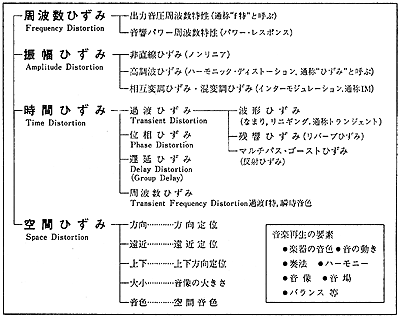 |
| <Table No. 1> Various distortions in the process of stereo playback(Mainly in the speaker system) |
There are not so many researches regarding time distortion and space distortion. However, those are very important factors for music playback. Until the last issue, we showed new way of thinking on time distortion and proposed reverb distortion, mutipath distortion and momentary tone, etc.
However it's very hard to find an article about space distortion in audio magazines except listening evaluation of good or bad point on localization. Since space distortion will be the most important factor for the advanced expression of music , this time we would like to check carefully about this.
Competition between SPL and time difference for sound image localization
Generally speaking, the definition of the localization in conventional stereo is the direction localization in most cases. Those are produced from the sound pressure sound level difference between right and left speaker outputs. In the playback system, there is a balance control according to this principle. And in the recording console table, panpot, which is to determine the direction localization after distributing signals which are recorded in monaural to right and left channels, is the main function.
We cannot satisfy with only like this direction localization from the level difference (Fig. No. 1B). It was O.K. in the conventional system, since it has not enough faithfulness in time domain, however when the faithfulness become high-level likewise our experimental system, we have to consider about localization including phase and position.
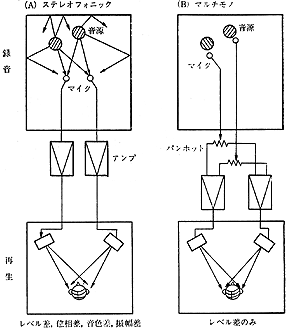 |
| <Fig. No. 1> Typical model sample for recording and playback in stereo system. |
We will playback the impulse at the same time from right and left using our experimental speaker. If you listen to the sound at the top of an isosceles triangle, the impulse will reach to right and left ears, the sound will be localized in the center. If we delay the right impulse by using a delay device, the sound will be closer to left. It sounds like the sound is coming from the first reached position.
Next, we will put only level difference without time difference. Even you put the level difference like 2dB, 3dB, the sound will come out from the center. This is the value which sound travels clearly in a normal condition, however in this case the impulse will reach to right and left ears at the same time, the sound will come out from the center. If you set the difference to 5dB, 6dB, the sound will go away from one side to the other starting from a certain level. Since only one side sound is possible to hear. Time difference is controlling
and looks like nothing to do with level difference.
Then how about in the case of transient signals like music and announce. These are moving from one side to the other side even though they have level difference. But also moving by the time difference. We can get more clear sound image by the time difference than level difference.
There are some competition between level difference and time difference. If you make the right signal delayed about 600mS, the sound image will move to the left speaker. If you raise the right speaker level, it will return to the center as it used to be around at 5dB. Since it is the center localization as a result of indicating the contrast position of time and level information, the quality of the localization is not so good. This means, on the contrary, if both information are in harmony with each other, we can get good localization. In stereo playback, it is commonly said that the center localization is bad for female vocal and 6.3kHz band noise, however this speaker will make a high quality localization.
In the localization experiment by transient sound, the level difference localization seems to dominate in case of conventional system which is not so good in time faithfulness.
In case of continuous sound, level difference will be dominating. With level and time difference, only direction will be determined based on a theory, however, if you listen to music with good system, you will be able to get touch with depth and sound image. There are various views regarding to recognize perspective shown in Table No. 2. Anyway as these are very advanced and sensitive information, it is very difficult to playback without high-faithfulness.
<Table No. 2> Perspective and physical property
| near | far |
| sound level | big | small |
| tone | vivid | dull |
| high-level at frequency characteristics | flat | drop |
| direct sound and reverberation | much direct sound | much reverberation |
If considering in time domain, it seems like we can playback the sound stage and sound image based on a theory like Fig. No. 2. Conventional research about sound source localization used to be considered with direction information in the frequency domain of head transmission function. On the contrary, Mr. Hiranaka of Tokyo University is considering in time domain of ears-relating response. He has been successful in the localization likewise up and down, right and left, front and back, and seems very reasonable.
If we interfere the wave surface by putting a small obstacle in our experimental horn system, then the sound will be getting closer to conventional sound due to multipath ghost and ghost distortion. At the same time with the deterioration in the quality of sound faithfulness, the localization factor will become worth. We can suppose that this way of thinking is correct, since not direction but perspective , width, reality of sound image and size are spoiled.
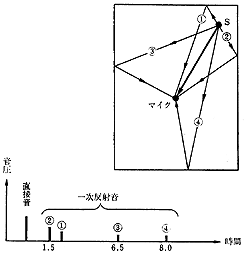 | 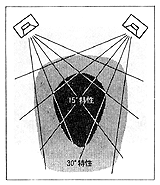 |
| <Fig. No. 2> The condition of recording and perspective simulation. | <Fig. No. 3> Directivity as a necessary condition. |
How to think about directivity
There is also some ideal image for directivity. We used to define
"good" if it has a wide directivity, however width and good are different subject. It is clear that wider is better naturally for theater and PA, but it's not recommendable to apply to listening room as it is.
See Fig. No. 3. If you look for an excellent sound image localization with time information added, it is not recommendable to move away from the centerline. Regarding the level difference, we can utilize the balance control in case of off the center, but we cannot change the time difference.
Strict faithfulness is required until 15 degree. If we guarantee until 30 degree it will be enough. "Good" directivity means SPL is decayed more than 30 degree without any degradation. The element of more than 60 degree is harmful since it will produce strong first reflectiion sound which is less time difference at side wall. The same reflectiion sound is useful in the concert hall, however we should not confuse the situation since the mission and principle are different between concert hall and playback soundstage. This
confusion is the case of audio equipments and materials including speaker also indoor sound effect, and we should be very careful.
The experimental horn which results is shown in Fig. No. 4A acquired completely equivalent signals in the necessary angle at frequency and time domain. This is necessary condition to playback sensitive tone and real sound image at each moment in the space. After getting rid of multipath ghost distortion and reverb distortion, and controlling radiation angle in the wall design, then acquiring coherent wave.
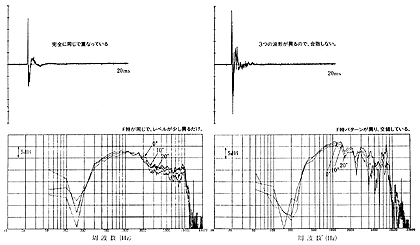 |
| <Fig. No. 4A> Directive property of experimental horn, and impulse response. | <Fig. No. 4B> Directive property of horn made in abroad (with lens) and impulse response. |
S/N and the sense of hearing
We can say that good system is superior in sound image localization, and also good at localization for sound image, so it will be possible to playback real sound.
Real sound could be playbacked since each element assembles to the original space, and no colorization exists. In the part of phase and time distortion in the August issue (New approach how to playback high-faithful sound (2)), we emphasized that correct sound will not be playbacked at any time if each element of the sound is distributed neglecting time factor even the proportion of elements were correct. It is also the same story for space. If adjacent two instruments sound were mixed, it will be fairly similar sound and color tone numbers will be decreased to compare with real music.
Human being can tell one voice from another among many conversations. We call this as "a cocktail party effect". They can distinguish in the level of S/N 0 dB by using excellent pattern recognition ability. If you could compose the correct elements in time and space, this ability will be improved more.
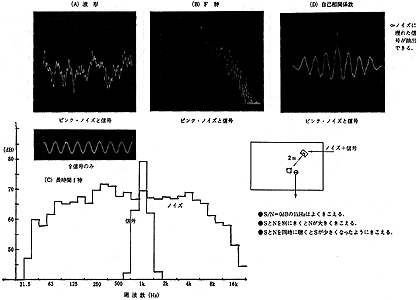 |
| <Fig. No. 5> Various properties of 0 dB sound to compare with SN. With this condition, the contents of music is very clear. |
We will show you one experimental example to indicate the difference between measurement and the sense of hearing.
We can make S/N 0dB sound with pink noise and 1kHz sine wave(Fig.No.5A). It is clear that the sound is 1kHz if you listen. Frequency response of short period of 20mS is B. Long period frequency response is C. Noise will be averaged, so it is clear than B. The reason for this maybe the value of S/N10dB around signal elements even though 0dB in case of total elements. Also as indicated in D, signals will be more clear if you take self correlation since the properties are different between signals and element nearby. It looks like the sense of hearing of human being has like this function.
Then, we will reduce 1 kHz level until ears cannot recognize the sound (Fig. No. 6A). We can recognize until -20dB, the degree which can only tell the genre in music. We can recognize until some more dB worse, if we spread the noise over the space after making it to stereo sound(as all factors of realistic noise are random), and fix the sound at arbitrary position by panpot after making the signals to monaural.
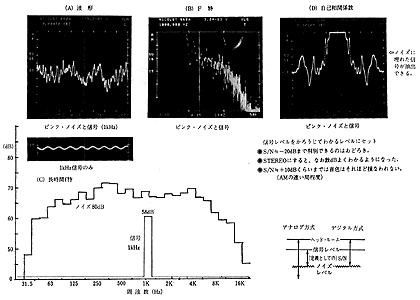 |
| <Fig. No. 6> The conditions seems like hearing possible limit. In case of music, to the extent we can tell the genre. |
In case of low faithful system, the story will be different. However in high faithful system, all frequency, amplitude, time, space, will be possible to use until 20-30dB below from the measured value S/N = 0 which has been defined.
This is the reason why we can perceive the sound with wide dynamic range in the new approaching system. Also this is the reason for playback of sensitive timbre, sound image, and necessary reason for the playback of faithfulness in time and space.
In addition to the subject of space timbre, sound image localization is attractive itself. We keenly understand that faithful playback of sound image will be the necessary condition if you can realize the realistic movement at the opera theatre and acting people, and can tell each voice and expression in the chorus, and can distinguish the numbers of strings and each timbre and performance in orchestra.
We will add some information to S/N issue.
We cannot discuss about the digital system which has no signals below noise level and analog system which has effective signal element below noise level at the equivalent condition. Also according to the same reason, the evaluation will be different depend on quality and level of the instrument which is used for evaluation.
Noise gate will be enough if we only prefer to raise dynamic range on the measurement data and some kind of sense of hearing. In this case, the another dynamic range will be lower in the sense of hearing. This is just for your information to give you a hint on the meaning of the measurement data and what is the sense of hearing.
Note) Noise Gate: A device to cut off the signals which is under a
certain level to prevent mixing up the sounds of other instruments
in case of multi-monaural recording.
About listening
This research had started from listening to music and sound.
If you started from measurement and theory, it may have a big possibility to misunderstand the situation. Because there are still many mysterious points in theories and physical properties. However human ears and music have been existing for a long time. Please start to enjoy audio with your ears and your favorite music.
There are many opportunities for listening offered by academic circles and research institutes, and they seemed to have many issues as same as theory and measurement data. As we don't have enough space, I will list up issue points as followings.
1) Need to examine the purpose and condition of listening. It sounds like nonsense to try to get data regarding localization in the system which has bad localization characteristics, and try to get the detection limit in the system which distortion is not so good. Also we have to review the data which supposed to establish the theory long time ago by experiment and the quality of the instruments were not so good to compare with the present one. There are many cases which seem like to turn out different data and results if we have done additional experiment with high faithful system.
2) Systems to collect many panelists and hold a listening and get a result from a pair comparative method are authorized but some of them are not so effective. Professionals should evaluate the quality of high level sound such as other responding detection. In the industry of perfume and wine, professionals are evaluating precisely in high level which is impossible for amateur.
3) We have to use the data regarding limits after checking exactly the level for the purpose. Please understand it is not always suitable to apply average value for the general public as the basic data for equipments specialized to ultra-maniac.
4) We need more concrete and objective expression to evaluate sounds although some words are authorized already. For example, which part of drum is what, and which part of string is how , etc. We can not imagine actual condition of high level sound by using vague expression.
5) We always have to check the difference of quality and colorization to make a judgment on good and bad for audio instruments. In case of faithfulness has arisen, at the same time information volume will increase. In other words, the number of color will increase and it will be possible to tell the difference which used to be difficult to distinguish. It's the same with sound image localization. In case of colorization, information volume remains same or going to decrease even if it sounds favorable. So we can tell the definition of good from this point, if it's favorable from the way of colorization or from the consid eration of quality . Finally, we cannot playback high level music without the improvement of quality.
Last, I would like to quote the words of C.J. Lebel from "Psychology of hearing" written by Mr. Souichiro Kuroki. "If it measures good, and sound bad, it is bad."
Please trust your ears and keep looking for the best sound in audio system.
|